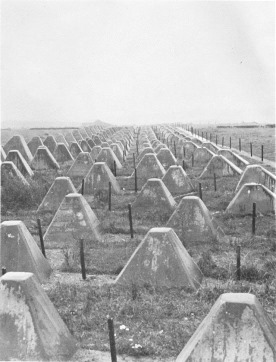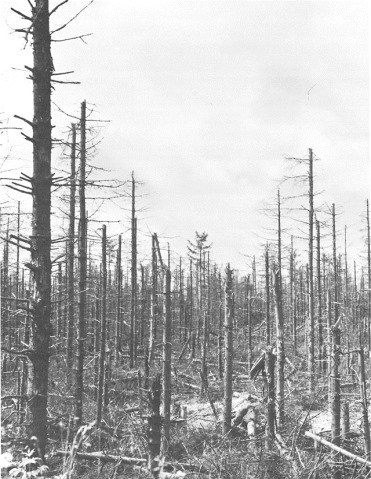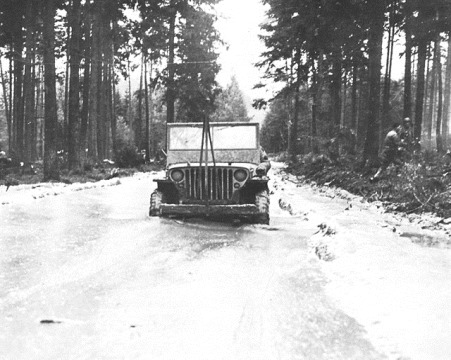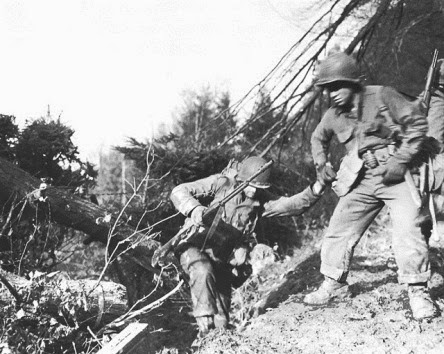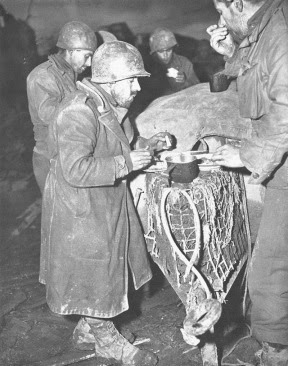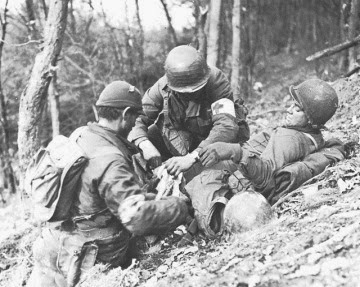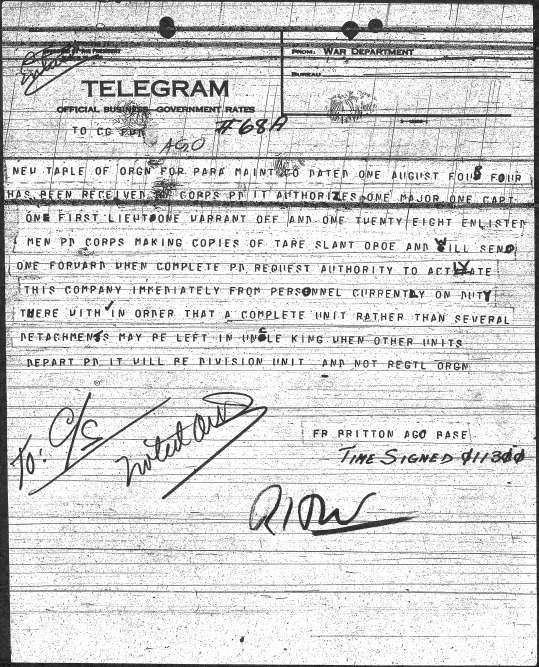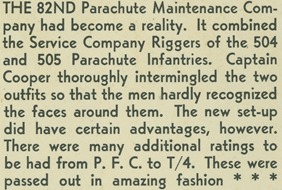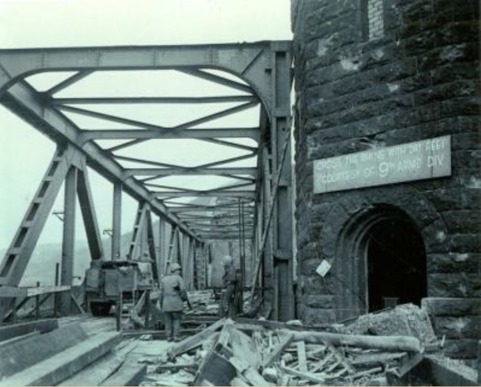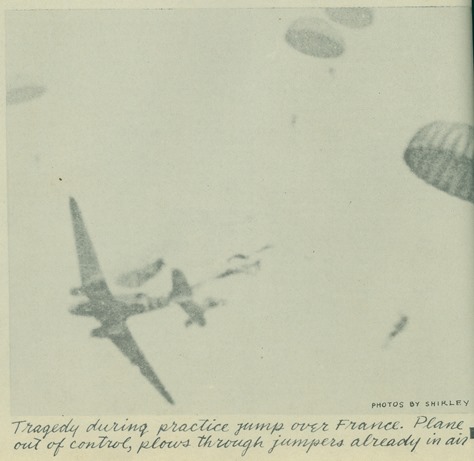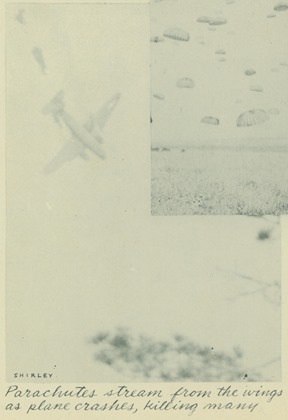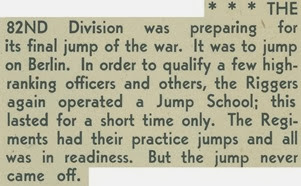Today is the anniversary of an inconspicuous, yet in many ways historic event in the annals of the 82nd Airborne Division. It is the 69th anniversary of its return to the bases in the vicinity of Reims, France after fighting the “Winter War” of 1944/45.
This is a significant anniversary because it had been 65 days since the paratroopers had made the fateful “truck-borne” journey to the Ardennes Forest and the epic battlegrounds around the Salm River in Belgium, where so many young citizen soldiers lost their lives halting the German armored spearhead speeding towards the Belgian port of Antwerp.
It is also significant since the Ardennes, for these men, was to be their last great battle of the war. There was more combat to come, but never again would they be called upon in desperation to defeat the enemy against such overwhelming odds. This has evoked a bitter sweet duality of emotion in the hearts of many 82nd veterans. The end of the war was close and every man craved for it because making it to the end meant he would have survived the impossible. At the same time most men wanted to be there at the end to play some part in what would inevitably be a valorous victory battle followed by a grand aftermath.
For most of the time during the Ardennes campaign the men had been in combat with a few days rest between battles. After it was finished, with the elimination of the “Belgian Bulge”, the 82nd troopers were summoned once more to fight in the area designated at the time as the “Germany campaign”; the name for which was later changed to, and included as part of, the “Rhineland campaign” (which had begun on September 15, 1944 with the airborne drops code named Operation MARKET).
So it was to be, that these brave men who had suffered through so much, and serving in units down to about 30 percent strength, had one more battle to win before they could return to Reims to rest and receive replacements.
The Fight to the Siegfried Line and the Roer River via the Hurtgen Forest, Germany
By January 31, 1945, the 82nd Airborne Division together with the famous US 1st Infantry Division in their sectors had pushed the Germans back to their border. On February 2 they had penetrated two miles into Germany, right into the midst of the “Toblerone” like pyramidal antitank defenses known as the “Dragon’s Teeth” found along the Siegfried Line. Both Generals Gavin and Ridgway felt anger at higher Headquarters that – given the costly elimination of the Belgian Bulge – their Division’s valuable penetration of the German defenses at the Siegfried Line was not to be exploited. Instead the US 99th Division was ordered to replace them in a defensive holding position.
Not only did this decision to halt the attack, while the enemy was in retreat allow the Germans to regroup in a short term tactical sense, it gave them much needed time to prepare strategically for the defense of the Fatherland by digging in along naturally advantageous lines of defense, as well as setting charges for blowing bridges and dams.
“Dragons teeth” – Antitank Obstacles along the Siegfried Line, Germany
Source: MacDonald, C., “United States Army in World War II. European Theater of Operations. The Siegfried Line Campaign.” 1963, p. 1 Retrieved from http://www.ibiblio.org/hyperwar/USA/USA-E-Siegfried/img/USA-E-Siegfried-front.jpg
Several days after its relief by the 99th Infantry Division the 82nd was again called to help in another crisis. This time it was the capture of the Roer River dams before the retreating Germans could destroy them, thereby flooding the Roer River valley, turning it into a formidable natural defensive barrier to further invasion. For two weeks the 82nd fought with other units to secure the dams.
While executing their part of the plan to reach and secure the the dams, the men of the 505th PIR had a front row seat in the horrific outcome of a series of completely unnecessary and extremely bloody battles which had taken place during the previous Autumn of 1944 in a region of western Germany adjacent to the Roer River known as the Hurtgen Forest. As the men advanced toward their objective they experienced some resistance, but what their eyes witnessed in the Hurtgen left them with profound and permanent psychological scars. The American 112th Infantry Regiment of the 28th Infantry Division had fought there in September of 1944 and had been annihilated.
Walking through the places of the Hurtgen in February of 1945 that had sustained the most intense artillery bombardment was like walking on the moon. The scenes reminded the men of stories they had heard from their fathers and uncles about the First World War. Entire towns were reduced to piles of rubble. Trees were flattened or blown to bits. Nothing was left standing. About half way in things got really gruesome. Masses of unrecognizable gore and dead bodies were emerging from the winter’s snowmelt. The faces of the half frozen corpses still wore ghastly fresh looking death masks. Men were physically sick at the sight. The fact that the dead had been left for several months without a dignified burial was an unforgivable travesty in the minds of the witnesses. It was every soldier’s worst nightmare to die and be left to rot on the battlefield. They could see their own fates in the dead men surrounding them and it deeply troubled them.
A Bombarded Section of the Hurtgen Forest
Source: MacDonald, C., “United States Army in World War II. European Theater of Operations. The Siegfried Line Campaign.” 1963, p. 375 Retrieved from http://www.ibiblio.org/hyperwar/USA/USA-E-Siegfried/img/USA-E-Siegfried-p375.jpg
At the first chance after his arrival General Gavin, in an early morning reconnaissance of the Hurtgen, came upon the scene (surprisingly, he was one of the first high ranking commanders to visit the place) and quickly reconstructed the battle. The 112th failed to achieve their objective and got stuck. Then while in full retreat its men were ruthlessly annihilated by merciless German artillery bombardment. Around 100 tanks and nearly all the men were killed. Even the Aid Station where the wounded were being readied for evacuation had not been spared. The red keystone shaped shoulder patch of the 28th Infantry could be seen on the corpses. After the massacre it became known as the “Bloody Bucket”.
Gavin was scathing of the foolhardy military strategy used to justify the offensive through the Hurtgen Forest – the objective of which was capture of the Roer River dams on the opposite side of it. The path chosen to traverse the forest was a muddy slippery trail which wound its way through the Kall River valley, up and down steep gorges. It was a path though a veritable valley of death and it could have been avoided.
Just to the north a paved road across the high ground leading directly to the objective could have been used instead. It would have bypassed the Germans and avoided the disadvantage of using the low Kall valley floor with enemy artillery positioned above it. Tens of thousands of lives could have been saved and were not. General Gavin used this alternative road and the 82nd Airborne captured the west bank of the Roer River in one day; a feat that a succession of units had failed to achieve in six months. Despite the 82nd’s accomplishment, ultimately the mission was unsuccessful and the Germans later blew the dams, flooding the Roer River valley region.
As it was, the chosen road through the forest completely favored the defender. The Hurtgen Forest is a vast continuous undulating hill mass, cut through by steep sided valleys, completely covered in dense evergreen and deciduous foliage. These features made the German fortifications underneath the forest virtually impervious to Allied air bombardment. In 1944 the area was crossed by trails of deep mud which severely hampered any vehicular traversal. The Germans took full advantage of the natural impregnability. As the war turned against them time and again they had demonstrated a conspicuous talent for defensive warfare. The battle of the Hurtgen Forest was to become a perfect example of the Germans defensive expertise in as much as it was a catastrophe for the Americans – “our Passchendaele” General Gavin wrote later, in reference to the British Army’s nearly incomprehensible loss of 240,000 men in the WWI battle of the same name and characterized by striking similarities.
Left: A Jeep stuck in a muddy road through the Hurtgen Forest Right: US Soldiers Fighting Their Way Up Steep Bombed Hillside
Source: MacDonald, C., “United States Army in World War II. European Theater of Operations. The Siegfried Line Campaign.” 1963, p. 435 and p. 456. Retrieved from http://www.ibiblio.org/hyperwar/USA/USA-E-Siegfried/img/USA-E-Siegfried-p435.jpg and http://www.ibiblio.org/hyperwar/USA/USA-E-Siegfried/img/USA-E-Siegfried-p456.jpg respectively.
For the Americans there had been a staggering 32,000 casualties in the battles of the Hurtgen Forest. 23,000 of them were battle casualties and 9,000 non-battle. It stands as one of the worst military defeats in US Army history. Source: MacDonald, C. Siegfried Line Campaign Center of Military History, United States Army, 1984.
Left: Veterans of the Hurtgen Forest. Right: Medics Attending Wounded in the Forest
Source: MacDonald, C. “United States Army in World War II. European Theater of Operations. The Siegfried Line Campaign.” 1963, p. 458 & 468 Retrieved from http://www.ibiblio.org/hyperwar/USA/USA-E-Siegfried/img/USA-E-Siegfried-p458.jpg and http://www.ibiblio.org/hyperwar/USA/USA-E-Siegfried/img/USA-E-Siegfried-p468.jpg respectively.
After the war, General Gavin wrote critically of the massacres in the Hurtgen:
“The Hurtgen was an incredible battle area with its concrete pillboxes deeply imbedded in the surface of the forest, the whole landscape covered by German machine-gun and artillery fire. It was into this that the 9th Infantry Division drifted on September 19 [1944]. In less than four weeks the [9th Infantry] division lost 4500 men, one causality per yard gained. As the official history – U.S. Army in World War II, The Siegfried Campaign - sums it up, ‘The real winner appeared to be the vast, undulating blackish-green sea.’ [of the Hurtgen Forest]”…The 9th Infantry Division was followed by the 28th Division…[which] suffered more than 6000 casualties. The 28th was followed in turn by the 4th, the 8th, the 83rd, and a combat command of the 5th armored Division…Once we were into it, the higher command did not seem to appreciate the incredible conditions under which the infantrymen had to fight. Unlike other battles in Europe so far, we sacrificed our ground mobility, our tactical air support, and we chose to fight the Germans under conditions entirely to their advantage – where they had strong fortifications and were on ground they knew very well.” Source: Gavin, J. “On To Berlin: Battles of an Airborne Commander 1943-1946 ”, 1978, p. 267 – 268
The Hurtgen Forest today looks very much as it did in the Autumn of 1944 before the battle to secure the Roer River dams began
Source: Wikipedia Creative Commons License. Author: W. B. Wilson at en.wikipedia. In no way does the author endorse the content of this blog or the use of this photo.
82nd Airborne Division Returns to France & Re-Organization
The 9th Division relieved the 82nd airborne of its zone of responsibility in the Hurtgen area on February 18,1945. Over February 20 – 21 weary from their prolonged combat and the horror of witnessing the Hurtgen Forest massacres, the paratroopers had all returned to the Sissonne and Suippes camps in France. Army hospitals had taken over the barracks at these camps so the 505 PIR, 508 PIR, and 325 GIR had to bivouac in tents in the surrounding area. The 504 PIR was relocated to nearby barracks at Laon. Source: LoFaro, G., “The Sword of St. Michael: The 82nd Airborne Division in World war II”, 2011, p. 525.
It was a sad time for all:
“…in one of the heartbreaks of the war, the independent 509th and 551st Parachute Infantry Battalions were disbanded, and the survivors from the ‘Bulge’ divided up among units of the 82nd, in the course of which the 505 received many of them. In reality of truth, just as so many old 505ers died in the snowy hills of the Ardennes, so too, the old 505 died there. The regiment was now made up of a scattering of ‘old men’ whose greatest hope at this stage of the war was to survive it, fresh-faced kids who had no idea of what it was all about, and the veterans from the 509 and 551 who retained loyalties and allegiance to their old outfits.” Source: Langdon, A. “Ready: A World War II History of the 505th Parachute Infantry Regiment”, 1986, p. 122.
The first days of the return to camp consisted of physical training since a policy of liberal passes was established. Three day passes were given for men to London, Paris, Brussels, and the French Riviera. Some very fortunate troopers were given furloughs to the US. Ceremonies for the fallen were held and replacements were assigned to units. New men who needed it were sent through the parachute qualification course. After a short time, 0nce the men absent on passes and furloughs returned, the training became more intensive including tactical exercises, and parachute/glider assaults.
On March 1, nine days after arriving back in camp, War Department Orders of December 16, 1944 took effect. These orders significantly altered the Division’s TO&E (Table of Organization and Equipment). Among the changes was a consolidation of an airborne division’s Glider Infantry Regiments (GIRs) which were ordered to have three battalions instead of two. For the 82nd Airborne the 2nd battalion, 401st GIR had become an organic unit of the 325th GIR instead of being attached as it was previously.
The number of Parachute Infantry Regiments (PIRs) in an airborne division were reduced to two instead of three. The 505th, and 504th PIRs stayed with the 82nd Airborne, while the previously attached 508th PIR was detached and given the role of liberating Allied Prisoner Of War (POW) camps in the possible event that Germans committed reprisals by killing Allied POWs before their liberation. It moved base to Chartres, France and was put on a 48 hour alert to carry out its orders. However, since the Germans never murdered POWs in camps, the 508th was never needed for that mission. Instead it eventually ended up in Frankfurt Germany as General Eisenhower’s honor guard at his post-war headquarters and returned to the US after a long period of occupation duty which ended in November, 1946. Source: LoFaro, G., “The Sword of St. Michael: The 82nd Airborne Division in World war II”, 2011, pp. 530 – 531.
There were further changes prescribed in the War Department Orders which affected smaller units in the 82nd Airborne. One such change affected Bill’s unit in particular, the 82nd Parachute Maintenance (Provisional):
“…the poignant date of March 1st rolled around. A mass huddle was called and these gallant troopers, all but the 508 section, were told that they were now members of the same company. That by authority of T/O and E71-27T, War Department, Washington 25, D.C, 16 December 1944 and General Order No. 25, Headquarters, 82nd Airborne Division, 1 Marcht [sic] 1945, they were now known as the 82nd Parachute Maintenance Company. Captain [Wiley] Cooper was now officially Company Commander with first Sergeant Brown as First Sergeant. On this same date, Captain Griffin was promoted to Major to be the 82nd Airborne Division Parachute Maintenance Officer.” Source: Author Unknown, “82nd Airborne Division: 82nd Parachute Maintenance Company” Section 1 Unit History, Date unknown, p. 13.
Requests for the reorganization of the 82nd riggers provisional unit had been under consideration for some time as this telegram dated August 1, 1944 shows:
Telegram of August 1, 1944 requesting authorization to active the Divisional 82nd Parachute Maintenance Company
Source: Telegram dated August 1, 1944 “Maneuver Center of Excellence Libraries Donovan Research Library US Armor Research Library Historical Microfilm Documents Collection “D78 Item nos. 2000-2019 - United States Army 82nd Airborne Division narratives from operations in Sicily, Italy, Normandy, Holland, Ardennes, and Central Europe, August 1942-May 1945” Retrieved from http://www.benning.army.mil/library/content/Virtual/Documents/Microfilm/index.htm which can be found at http://www.benning.army.mil/library/content/Virtual/virtual.htm Direct link to the PDF file: http://www.benning.army.mil/library/content/Virtual/Documents/Microfilm/film/D1-D630/D78_I2000-2019.pdf pp. 716
In the immediate post-war period after VE – Day some of the 82nd Parachute Riggers were given the opportunity to write an unpublished wartime history of their unit entitled “Our Outfit: The Story of the Parachute Riggers of the 82nd Airborne Division”. In it the effects of the reorganization are described:
Excerpt describing the creation of the 82nd Parachute Maintenance Company (from “Our Outfit: The Story of the Parachute Riggers of the 82nd Airborne Division” unpublished manuscript p. 78) Source: Author’s collection.
Bill’s brother Henry wrote a letter home to his sister Doris dated July 13, 1945 which indicates the timeframe for Bill’s promotion to Technical Sergeant 4th Grade (T/4):
“Dear Doris,
…Bill is a buck Sgt now. Coming up in the world…” Source: Henry Clark Jr. Letter dated July 13, 1945
Bill and Henry saw each other four times while on the European continent and twice in England. Bill’s promotion from private to T/4 most likely happened as part of the reorganization, since Henry didn’t mention it in his letters prior to March 1.
Operation ECLIPSE – the Proposed Jump on Berlin
While these changes to the organization of the 82nd were taking place, the men were gearing up for a new assignment. Rumors spread about where the mission might be, but not about what type of mission. Multi-jump veterans could tell by the specificity in practice jumps, and tactical exercises that they were being trained for a major combat jump.
In actuality the 82nd had not been assigned to any specific mission, but they had been earmarked for expected missions. The wide and turbulent Rhine River created a very effective natural barrier into the Germany territory still held by enemy forces because most of the bridges over it had been destroyed by the retreating Wehrmacht following the Ardennes campaign and the continuing Rhineland campaign. In order to overcome this obstacle several competing airborne operations were on the drawing board of the Supreme Headquarters Allied Expeditionary Force (SHAEF) planners.
One was Operation CHOKER II which called for the 82nd Airborne to jump as a support unit to aid in the US 7th Army’s crossing of the Rhine River at the German town of Worms. Another called Operation ARENA was a daring plan built around the concept of creating a fortress deep in the heart of Germany about 100 miles east of the Rhine River. It would have captured the defensible high ground dominating the area near Paderborn, Germany. This would have enabled the western Allies to support the advance of General Bradley’s Army Group from its positions on the Rhine and allow it to quickly seize the territory in between.
There was, however, one plan coveted above all others. It was the audacious and aptly named Operation ECLIPSE – the plan to drop a combat force composed of one British airborne brigade and two US airborne divisions onto airfields around Berlin. Once the paratroopers and glider men seized the Nazi Capitol, they would take control of the city’s services and its citizens, capture incriminating documents, round up high ranking Nazi officials, before waiting for a rendezvous with advancing Allied ground forces. Source: LoFaro, G., “The Sword of St. Michael: The 82nd Airborne Division in World war II”, 2011, p. 526.
In the first week of March 1945, General Gavin was told to prepare for ECLIPSE. Although there was ambiguity surrounding its certainty, Gavin prepared his men in earnest. He knew they could tell the training was designed for another epic mission. Seeing no point in hiding it he added to the already swollen rumor mill by announcing in a speech to the men the potential for a combat jump on Berlin. At the same time he suggested that other missions were also possible including deployment to the PTO (Pacific Theater of Operations) to fight the Japanese. Source: Ibid.
While to a lesser degree the 82nd men wanted the war to end without having to fight another battle, they also harbored a stronger desire to play a part in on the last one. They were happy not to be part of Operation VARSITY; Field Marshal Montgomery’s successful, yet costly capture of a bridgehead across the Rhine River in northern Germany using in part the US 17th Airborne Division, among other units. But they were glad to be doing something useful again when later they were given news of the Division’s assignment to active duty at the front.
This was a sentiment recorded in some WWII paratrooper memoirs such as John McKenzie’s excellent “On Time on target: The World War II Memoir of a Paratrooper in the 82d Airborne.” 2000, p. 161 and James Megellas’ gripping “All The Way To Berlin: A Paratrooper at War in Europe” 2003, p. 239. It was also reflected in Bill’s own actions when later, once the Division’s assignment was finally determined, he volunteered for a dangerous duty.
Gavin, like his men was of two minds about the prospect of another combat jump. He wrote a diary entry on March 12:
“I’d sure like to live through five combat jumps. I believe five are as many as one man should be given. Beyond that is too much. We all realize it now. There is a drain on the courage of a man that cannot be replaced.” Source: Booth T., “Paratrooper: The Life of General James M. Gavin”, 1994, pp. 281-282 & p. 281.
After the war General Gavin was to further elucidate his feelings (and those of his men) regarding Operation ECLIPSE:
“It was a sobering prospect, especially to the veterans with four combat jumps. But at the same time it was exciting. This was the final battle, and to be in it at the finish, after the long road from North Africa, was very much to our liking.” Source: Gavin, J. “On To Berlin: Battles of an Airborne Commander 1943-1946 ”, 1978, p. 269.
The 82nd PMC Prepares for Operation ECLIPSE
As was mentioned in “Bill Clark Scrambles to Reach His Unit in the Battle of the Bulge”, Bill arrived in Reims as part of an advanced detail (from Ashwell camp in the English midlands) to set up the new rigger facilities and/or as a member of the men running the rudimentary jump school that General Gavin had ordered prior to the Ardennes Offensive. The unpublished 82nd parachute rigger history, “Our Outfit” , lends further strong credence to explain Bill’s presence in Reims in early December, 1944 before the main force of 82nd riggers arrived on February 19, 1945.
“The [rigger] facilities [at Reims] were installed by the advanced detail which had arrived in December.” Source: Author’s collection. Embrey, W., (ed.), “Our Outfit: The Story of the Parachute Riggers of the 82nd Airborne Division”, 1945, p. 78
The History of the 82nd Airborne Parachute Maintenance Company further states that:
“The riggers moved into former stables which had been cleaned and fixed by the advanced detail…
Within a day or so [probably from February 20 - 21, 1945] the equipment arrived on convoys of trucks which might pull in at any time of day or night. All men would pitch in to unload and stack equipment in one mammoth storage shed. So much dust would be raised that the struggling lights emitting their feeble glimmer provided little more than a blacked out foggy London street. For awhile, a day and a night shift was organized.
As soon as possible one of the three platoons was formed to start packing chutes. The other two platoons starting within a few days. Maintenance was set up and began operating.
Regiments and battalions were scheduled to start training jumps so 7,600 parachutes were packed immediately. Time was precious; chutes were packed, jumped, and repacked within two days. As soon as the training jumps were completed the division needed 2,000 more chutes packed to jump another class of jump school students. At one time the three platoons packed 10,000 mains in approximately ten days, with the 508 section specializing in reserve parachute packing. Source: Author Unknown, “82nd Airborne Division: 82nd Parachute Maintenance Company” Section 1 Unit History, Date unknown, p. 13.
These parachute packing platoons gearing up for the 82nd Division’s practice jumps were separated from the men in the maintenance platoons which set up in a separate building. In addition to their usual parachute repair duties, these maintenance platoons were sewing orders of equipment for the 17th Airborne Division which was due to jump in Operation VARSITY on March 24, 1945:
“The maintenance section 504, 505, and 508 being set up together in one building, received another order for sewing on 15,000 pairs of combat suit jump pockets. In short time the maintenance men were putting out 900 pairs a day.” Source: Ibid.
Capture of the Ludendorff Bridge near Remagen, Germany & Demise of Operation ECLIPSE
On March 7, the US 9th Armored Division captured intact the Ludendorff railway bridge over the Rhine River near Remagen, Germany. This put US Army General Bradley’s Southern Army Group (rather than Field Marshal Montgomery’s northern forces) in a better position to lead the drive into Germany and eliminate the German forces defending the industrial war machine in the region known as the ‘Ruhr Pocket’. Under the old SHAEF plans, prior to the capture of the Ludendorff bridge, Montgomery was to lead his forces to seize the Ruhr and then move to capture Berlin. Source: LoFaro, G., “The Sword of St. Michael: The 82nd Airborne Division in World war II”, 2011, pp. 528 – 529.
American Capture of the Ludendorff Bridge over the Rhine River near Remagen. The sign reads: “Cross the Rhine With Dry Feet Courtesy of 9th ARMD DIV” Source: Wikipedia Commons
At this point, the western Allied objective was no longer Berlin. Instead it was the Ruhr Pocket. Soon after that, under pressure from the fast paced land grabbing Russian advance in eastern Germany which threatened to capture Denmark, the objective was to become the Elbe River.
With Berlin out of the picture, Operation ECLIPSE could never happen. Operation CHOKER II was cut because another main bridgehead over the Rhine River was no longer necessary. Operation ARENA was also shelved. SHAEF deemed the airpower needed to ensure its success would place too much strain on the air resources used to assist Bradley's objective of the Ruhr and the ongoing strategic bombing initiative of German cities. Source: LoFaro, G., “The Sword of St. Michael: The 82nd Airborne Division in World war II”, 2011, p. 529.
Famous Morale Boosting Singer Marlene Dietrich Attends a Fatal Practice Jump Accident
Despite the cancellation of these airborne operations, the 82nd Airborne Division regiments including the detached 508th PIR were still making training jumps to maintain their jump status, when on March 14, there was a terrible accident at the airfield near Sissonne.
Photographs of the March 14 C-47 crash killing seven paratroopers taken by 82nd PMC Rigger Emmitt Shirley of the 505 Section (from “Our Outfit: The Story of the Parachute Riggers of the 82nd Airborne Division”, unpublished manuscript, p. 80) Source: Author’s collection.
The 1st and 2nd Battalions of the 508th PIR were making their practice jump when a C-47 lost a propeller which caused it to lose control and altitude. As it turned downward the chutes of some paratroopers already deployed from the plane ahead were caught on its tail and wings. The airplane dived to the ground, crashing and bursting into flames, killing seven men.
The news quickly spread though the camps, but the details were kept from the men. Eventually they all were leaked including the fact that Marlene Dietrich (the German born famous morale boosting American actress and singer) was present for the jump. Even though it was a scheduled practice jump, Miss Dietrich was told by some officers that it was a parade jump held in her honor. She fell for this little white lie and after witnessing the crash became hysterical and remained severely distressed. Source: Nordyke, P., “Put Us Down In Hell: The Combat History of the 508th Parachute Infantry Regiment in World War II” 2012, pp. 483 – 485
All of the men present watched in stunned dismay as the disaster unfolded. 82nd PMC riggers were among the witnesses and one of them, Sgt. Emmitt Shirley took these photographs.
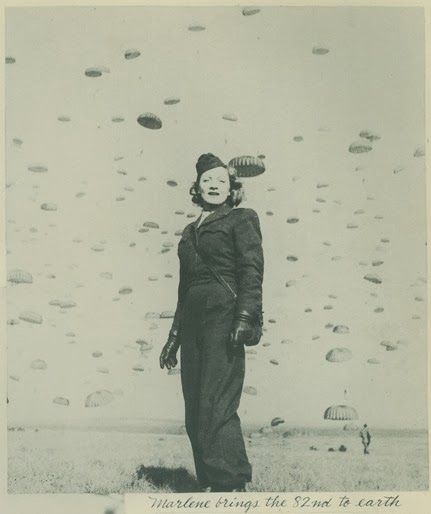
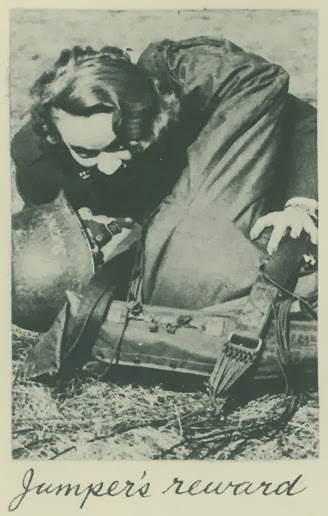
Photographs of the Marlene Dietrich attending practice jumps at the 82nd Airborne’s base in France (from “Our Outfit: The Story of the Parachute Riggers of the 82nd Airborne Division”, unpublished manuscript, p. 80) Source: Author’s collection.
General Gavin jumped with the 508th PIR just prior to the accident and saw the whole thing. He reacted by jumping a second time immediately following the crash. He also met Marlene Dietrich that day, and while unimpressed with her, later they did have a romance. Source: Booth T., “Paratrooper: The Life of General James M. Gavin”, 1994, pp. 281-282 & p. 308.
Photograph of Marlene Dietrich and General Gavin near the Sissonne Base, France (from “Our Outfit: The Story of the Parachute Riggers of the 82nd Airborne Division”, unpublished manuscript, p. 79) Source: Author’s collection.
Operation VARSITY
Eleven days after the accident, on March 25, 1945 Field Marshal Montgomery using the British Second Army crossed the Rhine near Duisburg in northern Germany as part of Operation VARSITY. In the first phase of the operation:
“The U.S. 17th and British 6th Airborne Divisions made a daylight jump [on March 24 to provide tactical support for Montgomery’s crossing of the next day] into drop zones on the east bank [of the Rhine River] to secure a bridgehead. They suffered substantial losses from antiaircraft fire during their approach. As was his inclination, Montgomery had spent so much time in meticulous preparation that he disclosed his intentions to the Germans, giving them plenty of time to prepare for the crossing. This was yet another serious intelligence failure. It also seemed foolish to route the flight paths used by the two divisions right over concentrations of antiaircraft guns that were positioned to fire on the streams of Allied bombers headed toward central Germany and the major cities there. Source: McKenzie, J. “On Time on target: The World War II Memoir of a Paratrooper in the 82d Airborne.” 2000, p. 161
The 82nd parachute maintenance platoons were also involved in supplying the 17th Airborne Division with equipment for Operation VARSITY. This meant a lot more work for the men of the 504, 505, and the officially detached 508 maintenance section:
“…Soon after the first order [the previously mentioned 15,000 pairs of combat suit jump pockets quoted earlier] was finished, another 12,000 pairs of combat pants were sent down to be modified for the 17th [Airborne Division]. They had chute repair and routine maintenance work to take care of along with these orders. Source: Author Unknown, “82nd Airborne Division: 82nd Parachute Maintenance Company” Section 1 Unit History, Date unknown, p. 13.
The unpublished 82nd parachute rigger history, “Our Outfit” corroborates the role of the 82nd PMC’s in the days before Operation ECLIPSE and tells of the cancelled Berlin jump:
Excerpt describing the role of the 82nd PMC in Operation ECLIPSE and its demise (from “Our Outfit: The Story of the Parachute Riggers of the 82nd Airborne Division”, unpublished manuscript, p. 78) Source: Author’s collection.
The 82nd Airborne’s Mission Finally Decided – Destination Cologne, Germany
On March 30, five days after Montgomery crossed the Rhine River, General Gavin was summoned to the 18th Airborne Corps at nearby Epernay, France where he received the 82nd Airborne’s orders:
“On 31 March the 82d Airborne Division was attached to the Fifteenth U.S. Army at 1400 [2:00 PM] and given the mission to patrol a section of the West bank of the RHINE River. This river was the Western boundary of a hugh [sic] ‘pocket’ of GERMAN resistance in the RUHR area. Aside from patrols the Division probably would not cross the river. Movement of the Division to the new areas would begin on or about 3 April.” Source: Author Unknown, “After-Action Report 82nd Airborne Division April 1945”, 1945 p. 1.
In the context of the bigger picture, initially Field Marshal Montgomery using his northern forces was to command the western Allied invasion into Germany, with the Americans providing a supportive role. However, a few days before Operation VARSITY began General Eisenhower decided that the US Southern Army Group under General Bradley would lead the advance and capture of the western Allied sector of Germany, with Montgomery’s forces in support. He let Operation VARSITY go ahead despite advice to the contrary in order to appease Montgomery. Subsequently:
“The U.S. First and Ninth Armies had linked up at Lippstadt, Germany, east of the Ruhr, on 1 April, after which Bradley assumed control of the battle and turned both armies inward to squeeze Model [General Field Marshal Model’s Army Group B – a force of over 300,000 Germans] from the north, south, and east. To complete the job, [General]Bradley needed a force to keep the Germans in the [Ruhr] pocket from escaping back across the Rhine to the west.” Source: LoFaro, G., “The Sword of St. Michael: The 82nd Airborne Division in World war II”, 2011, p. 531.
The stage was now set for the the 82nd Airborne’s participation in their second to last operation of the war – the reduction of the Ruhr Pocket and occupation of Cologne.
© Copyright Jeffrey Clark 2014 All Rights Reserved.

